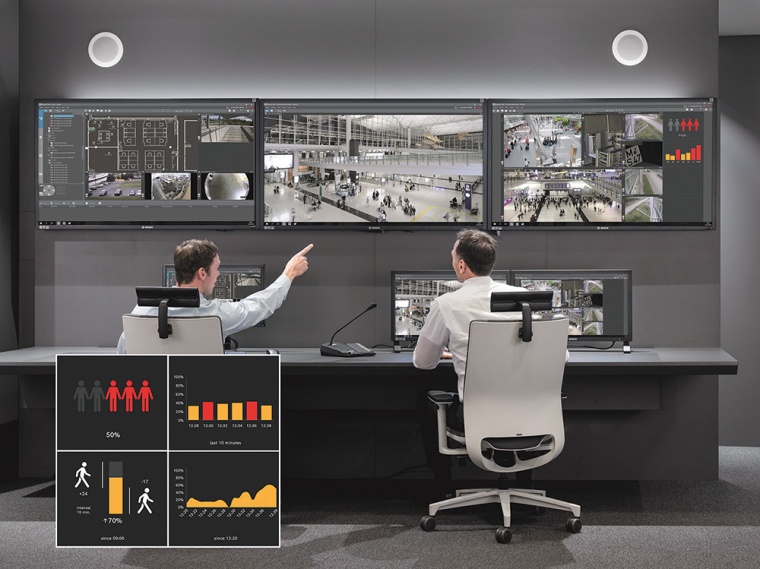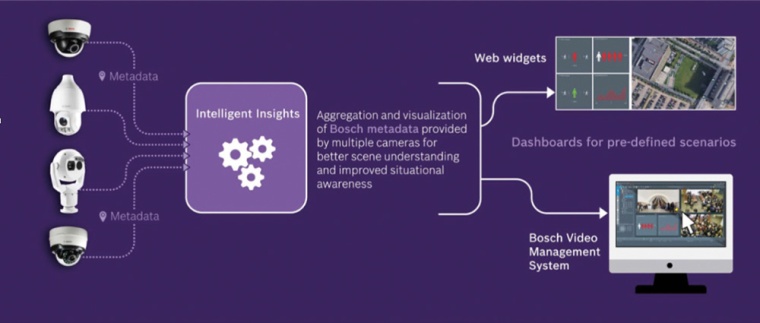As airport security responds to digital transformation and increasing passenger volumes, security cameras are evolving from ‘image providers’ to ‘data sensors’. Maarten Wings, global vertical manager airports at Bosch Security Systems, considers this development and how camera technology is transitioning to provide intelligent support to higher-ranked systems.
Airports have always been at the cutting edge of security camera technology. As highly complex security environments, airports demand seamless monitoring of large areas with tremendous passenger throughput, supplemented by extra rigid surveillance of high-security or off-limit zones. Meeting these demands, airport security control rooms have undergone a massive shift from analog to IP-based security cameras over the past decade. This new generation of digital cameras offers better image quality and benefits, like less cabling. As a result, IP-based cameras have now become the benchmark for comprehensive security at airports the world over.
But the next evolution is already on the horizon, as control rooms advance from IP to a data-driven approach. The reason why? Because image quality alone is not the answer to the challenges facing modern airport control rooms in terms of safety and security, as well as airports as a whole in terms of operational efficiency.
Airport Security on a New Scale
What exactly are these challenges? Ultimately, future demands on airport operators revolve around one single crucial factor: scale. Airports need to accommodate larger passenger volumes, as the number of air travelers per year is expected to skyrocket from 3.8 billion in 2016 to a staggering 7.2 billion passengers by 2035, according to the International Air Transport Association (IATA). At the same time, existing airports are expanding by adding new terminals, while newly constructed airports are mega-facilities on an unprecedented scale: The new Beijing Daxing International Airport is the world’s largest single-terminal airport at a size of 1.4 million square meters – twice as large as London Heathrow – and expected to process over 100 million passengers per year.
The number of security cameras required to safeguard airports of this size can easily reach over 10,000 installed devices. But with several thousand digital cameras installed, security operators are overwhelmed by hundreds of video feeds on their screens. And it’s no secret that after 20 minutes the average operator misses 90 percent of important scenes. This is exactly where the industry’s previous focus on increasing the image quality from IP-based video cameras is reaching its limits. More resolution, more HD, and higher bandwidth will not guarantee more secure airport environments when security personnel is overwhelmed by making sense of all this image data. Plus, the new scale of air travel poses challenges beyond just security.
The Bigger Picture
With more people traveling by plane each year, many airports are reaching the limits of their operational capacity. A single glitch in the computer system can leave thousands of travelers stranded for days, as happened in 2017 when over 20,000 passengers were grounded for three days due to an airline computer system outage.
From the perspective of airport operators, the only way forward is to increase operational efficiency and improve passenger experiences. Airports need to avoid congestion across terminals and ensure the optimal flow of passengers. Adding to the pressure, airlines are asking for lower turnaround times at the gates and shorter waiting times at security checkpoints – or they will move their business elsewhere.
On the back end, this focus on efficiency requires operators to make strategic decisions: for instance, when to increase staffing to meet higher passenger volumes at peak times and how to clear up bottlenecks in passenger flow. And, looking ahead, the ongoing process of digital transformation will require airports to adapt to new technological standards – for instance, the legislation on storage of video data – without disrupting operations.
Shifting the Focus
As an answer to these challenges, airports need to go digital. They need to shift the focus to becoming data-driven operations, both in terms of security and safety as well as operations. Realistically, this mind-change has to start in the security control room as the central hub where all data streams converge. As more data from larger airport terminals and more cameras streams into the control room, operators need help in making the most of this intelligence. Here’s where using neural networks and machine learning to turn data from ‘smart’ cameras into actionable intelligence comes in.
Already deployed in major airport installations around the world, cameras with built-in intelligent video analytics add sense and structure by adding a layer of metadata to video images. Processed ‘at the edge’ to reduce network computing loads, video analytics actively support operators on three major levels.
For security: breaches, loitering attempts and perimeter incidents can be automatically detected by video analytics to automatically alert operators and dispatch security teams for on-site investigation. For safety: there should be automatic alerts for fires, unsafe behavior, over-crowding of spaces, speeding incidents in garages, and blocked exits. These alerts can be configured to trigger pre-recorded messages over the public address system, such as “Secure area! Please turn back and leave immediately” to resolve situations automatically. For operations: ‘smart’ cameras can collect rich data in the field to detect congestion, measure occupancy rates and track processing times at gates as the foundation for optimization efforts.
In order to take advantage of these benefits, security operators need to accept that the future lies with the data, not in raw video images. It is metadata, combined with video feeds via task-related web widgets that will allow operators to address the new demands on security and operations facing modern-day airports.
Control Rooms of the Future
Most of all, this shift happens in the security control room, from where it will reach all parts of the airport organization. Drawing on rich data streams from field sensors, tomorrow’s ‘smart’ control rooms will be able to automate security and safety processes to relieve the operators. And they can also leverage data-driven insights beyond the security realm to make informed decisions on how to optimize operational efficiency for air travel on a new scale. Speaking of informed decisions, now is the time for operators to ensure that control rooms are connected to the necessary data streams. This starts with selecting the next camera system: Will the decision be based on image quality – or data performance?
Choosing data performance over image quality will future-proof your organization for what comes next in digital transformation. Instead of reacting to existing situations, metadata will empower airports to take a more proactive approach. On the strength of targeted first-hand data, they can finally understand why certain areas of the terminal become overcrowded or when additional staff are needed to ensure a smooth process during peak times. Looking ahead, intelligent insights driven by video analytics will even allow operators to prevent security incidents altogether. Drawing on insights gained from collected data – like when and how disruptions occur – they can take precautionary measures and eliminate threats before they become active scenarios.
What our industry needs to make it happen is a mind shift from considering a security camera as an image source to seeing it as a data sensor: a shift from IP to data. The data will carry you into the future of digital transformation. The image will not.
Is Your Video Security System Ready for a Data Shootout?
For the last ten years, it’s been standard practice for airport security managers to test the image quality of digital cameras in camera shootouts under realistic conditions. But with the paradigm shift from IP to data, we need a data shootout to see which camera delivers the most relevant metadata. Because looking ahead, only the best-performing data source is the most future-proof investment.
















